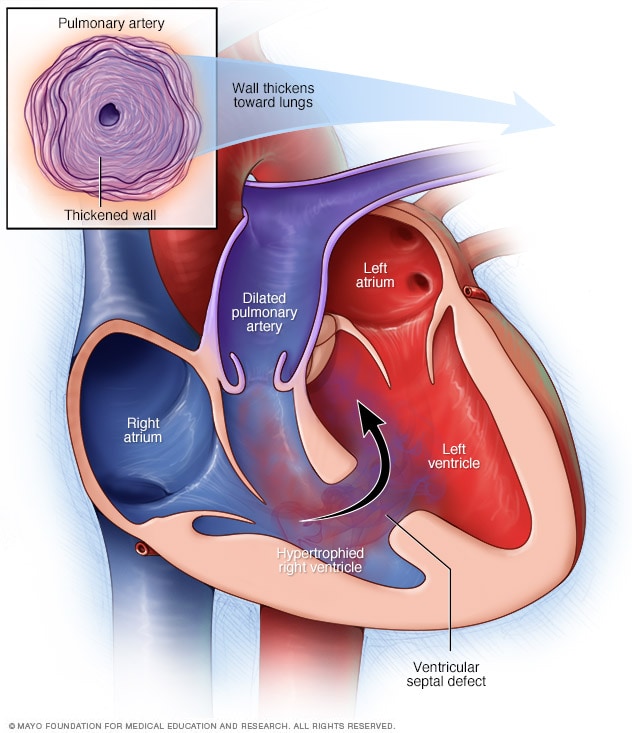Overview
Eisenmenger syndrome

Eisenmenger syndrome
Eisenmenger syndrome is most often a complication of having a hole between two chambers of the heart. The hole is called a ventricular septal defect. It causes more blood to flow to the lungs' arteries. Eventually the extra blood flow causes blood vessels to stiffen and narrow, increasing pressure in the lungs' arteries. The high pressure causes the walls of the right lower heart chamber, called the right ventricle, to get thick.
Eisenmenger (I-sun-meng-ur) syndrome is a long-term complication of an unrepaired heart condition present at birth, called a congenital heart defect. Eisenmenger syndrome is life-threatening.
In Eisenmenger syndrome, there is irregular blood flow in the heart and lungs. This causes the blood vessels in the lungs to become stiff and narrow. Blood pressure rises in the lungs' arteries. Eisenmenger syndrome causes permanent to the blood vessels in the lungs.
Early diagnosis and repair of congenital heart defects usually prevents Eisenmenger syndrome. If it does develop, treatment involves regular health checkups and medicines to improve symptoms.
Products & Services
Symptoms
Symptoms of Eisenmenger syndrome include:
- Blue or gray skin. Depending on skin color, these changes may be harder or easier to see.
- Chest pain or tightness.
- Coughing up blood.
- Dizziness or fainting.
- Easily tiring and shortness of breath with activity.
- Headaches.
- Large, rounded fingernails or toenails, called clubbing.
- Numbness or tingling in fingers or toes.
- Shortness of breath while at rest.
- Skipped or racing heartbeats.
When to see a doctor
If you have any symptoms of Eisenmenger syndrome, see your healthcare professional. Make an appointment even if you have never been diagnosed with a heart condition.
Get emergency medical help for symptoms such as shortness of breath or chest pain.
Causes
Eisenmenger syndrome is usually caused by an unrepaired hole between the main blood vessels or chambers of the heart. The hole is called a shunt. A shunt is a heart problem present at birth, which means it's a congenital heart defect.
Congenital heart defects that can cause Eisenmenger syndrome include:
- Ventricular septal defect. This is the most common cause of Eisenmenger syndrome. There is a hole in the wall of tissue between the bottom heart chambers.
- Atrioventricular canal defect. This is a large hole in the center of the heart. The hole is where the walls between the upper chambers and lower chambers meet. Some of the valves in the heart also may not work as they should.
- Atrial septal defect. This is a hole in the wall of tissue between the two upper heart chambers.
- Patent ductus arteriosus. This is an opening between the artery that carries oxygen-poor blood to the lungs and the body's main artery.
In any of these heart conditions, blood flows in a way it usually doesn't. As a result, pressure rises in the pulmonary artery. Over time, the increased pressure damages the smaller blood vessels in the lungs. The damaged blood vessel walls make it hard for the heart to pump blood to the lungs.
In Eisenmenger syndrome, blood pressure rises in the side of the heart that has oxygen-poor blood, also called blue blood. The blue blood goes through the hole in the heart or blood vessels. Oxygen-rich and oxygen-poor blood now mix. This causes low blood oxygen levels.
Risk factors
A family history of congenital heart defects increases the risk of similar heart problems in a baby. If you've been diagnosed with Eisenmenger syndrome, talk with your healthcare professional about screening other family members for congenital heart defects.
Complications
Eisenmenger syndrome is a life-threatening condition. How well someone with Eisenmenger syndrome does depends on the specific cause and if there are other medical conditions.
Complications of Eisenmenger syndrome may include:
- Low blood oxygen levels. The change in blood flow through the heart sends less oxygen to the body's tissues and organs. Without quick treatment, the oxygen levels get worse.
- Irregular heartbeats, also called arrhythmias. Eisenmenger syndrome causes the heart walls to get bigger and thicker. It also causes a drop in oxygen levels. These changes may lead to irregular heartbeats. Some irregular heartbeats increase the risk of blood clots that can cause heart attacks or strokes.
- Sudden cardiac arrest. This is the sudden loss of heart activity due to an irregular heart rhythm. If not treated immediately, sudden cardiac arrest can quickly lead to death. Survival is possible with fast, proper medical care.
- Heart failure. The increased pressure in the heart can cause the heart muscle to weaken. It becomes harder for the heart to pump blood.
- Bleeding in the lungs. Eisenmenger syndrome can cause life-threatening bleeding in the lungs and airways. Bleeding also can occur in other parts of the body.
- Stroke. If a blood clot travels from the right side to the left side of the heart, the clot may block a blood vessel in the brain. A blood clot in the brain can lead to a stroke.
- Kidney disease. Low oxygen levels in the blood may lead to trouble with the kidneys.
- Gout. Eisenmenger syndrome can increase the risk of a type of arthritis called gout. Gout causes sudden, severe attacks of pain and swelling in one or more joints, usually the big toe.
- Heart infection. People with Eisenmenger syndrome have a higher risk of a heart infection called endocarditis.
- Pregnancy risks. During pregnancy, the heart and lungs have to work harder to support the growing baby. Because of this, pregnancy with Eisenmenger syndrome poses a high risk of death for both the pregnant person and the baby. If you have Eisenmenger syndrome, talk with your healthcare professional about your specific pregnancy risks.
Aug. 28, 2024